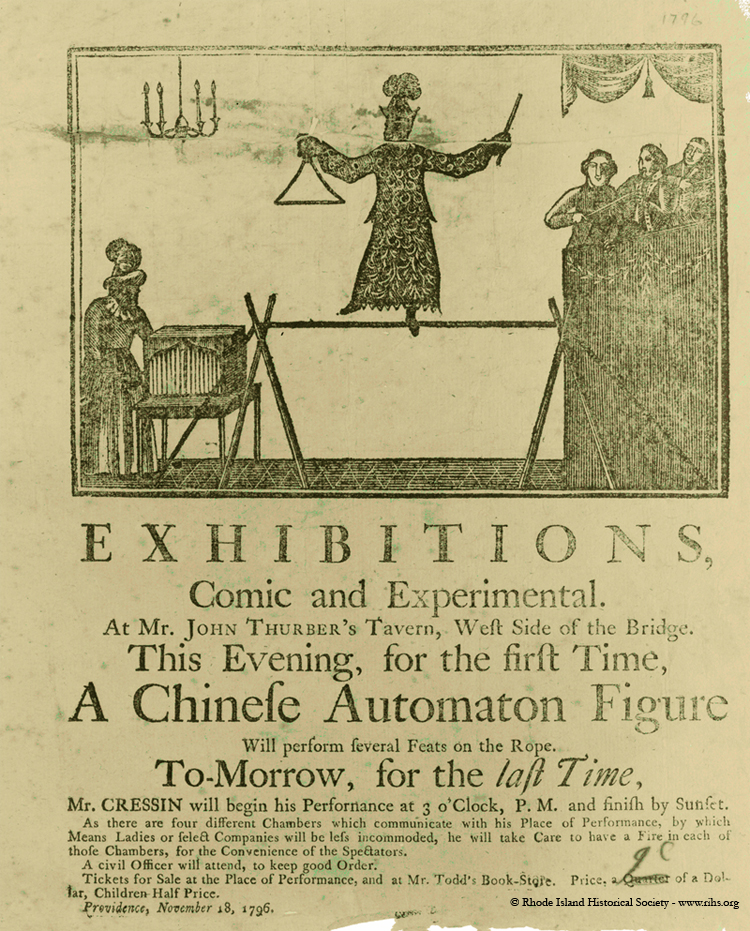The item described here answers the age-old question of what to do on a Saturday afternoon. In this case, the Saturday afternoon in question is November 19, 1796 at 3:00 PM. And the entertainment is a demonstration of a “Chinese automaton figure”.

Depicted above is a broadside from our graphics collection (Broadsides, 1796)*, which advertises the exhibition. An automaton is essentially a robot, and people have been building automata for centuries, ranging from programmable robots of the 1st century BCE, through a medieval floating robot band to automata that are still produced today (including the Chuck E Cheese animatronic animals).
In this case, the automaton performed “feats on the rope”—which, judging from the woodcut illustration, included playing a triangle on a tightrope: seemingly an impressive accomplishment for a robot even today. All this would be exciting enough in its own right, but this performance gains extra intrigue by showcasing a “Chinese” automaton. In 1796, it’s likely that the average Rhode Islander would never have seen anyone from China before. In fact, Chinese settlement in Rhode Island wouldn’t begin in earnest until late in the nineteenth century: the 1865 census reported only a single Chinese resident in the entire state.** As Lena Reynoso points out, “the first ‘foreigners’ exhibited in America often had no pulse.”***
Pieces of ephemeral advertising like this also offer a unique view into the social anxieties of their time. Note, for instance, that four separate rooms were to be provided in Mr. Thurber’s Tavern, ensuring that “Ladies or select Companies will be less incommoded” and that a police officer will be in attendance “to keep good Order.” Apparently the promoter, “Mr. Cressin”—who also toured the country with a pair of monkeys named Gibonne and Coco—was forced to relocate his show from Newburyport’s rowdy wharf area.****
And what was the cost of this entertaining afternoon? There are a number of ways to measure the relative worth of a 1796 dollar to a 2009 dollar, and they give a range of values for what that $.25 would be worth today:
- $4.20: A little less than today’s matinée movie ticket, if measured by the most literal scale, the Consumer Price Index.
- $68.99: A discount ticket to a Broadway show, if measured as a portion of the typical wage of an unskilled worker.
- $8,601.29: Buying a plasma widescreen TV and home theater sound system, if measured as a relative share of the Gross Domestic Product.
Throwing out the high value, it’s clear that a visit to the automaton exhibition would have been an expensive, if not prohibitively so, afternoon or evening of entertainment. But probably worth every penny.
* Alden, #1506
** See Patrick T. Conley, Rhode Island Ethnic Heritage Fact Sheets. Providence: Rhode Island Publications Society, 1980. pp. 34-6.
*** Lena Reynoso, “Tourism, Bodies and Display in America 1769-1900.” Early America Review (Winter/Spring 2008). http://www.earlyamerica.com/review/2008_winter_spring/popular-american-amusements.html. (Part of Archiving Early America, an ad-supported website)
**** Scott C. Martin, Cultural change and the market revolution in America, 1789-1860. Lanham: Rowman & Littlefield, 2005.

2 thoughts on “Robots in Providence”